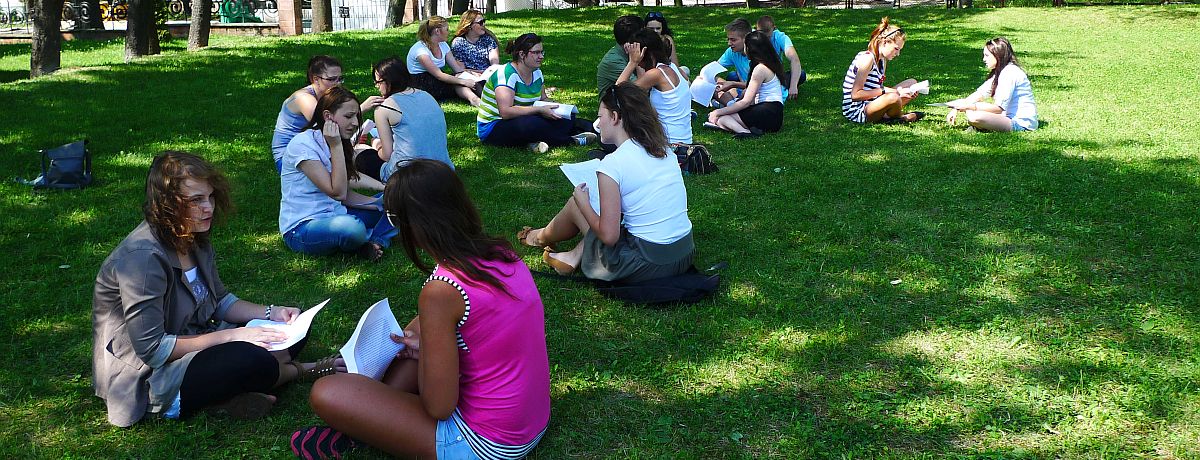| 2012 |
Busko-Zdrój
Tadeusz Kościuszko High School No 1


| 2012 |
As part of the School of Dialogue workshops conducted in Busko-Zdrój, students of the General High School no. 1 decided to turn into journalists/ethnographers. They wanted to find out what inhabitants of their town know about Jews and the multicultural past of Busko. They prepared a set of questions which they then asked to random passers-by. Reactions were varied. There was a lot of mistrust and suspicion, despite the fact that each student wore a school ID. Many people simply evaded answering or claimed that they did not know anything about it, they were not originally from the area, so the matter was of no concern to them. What could the inhabitants know about Jews in their town? Actually, there is ample information on the subject.
The Jewish Kehilla was established in the town in the 1880s. The community played a significant role in the town’s economic life. In 1888, the construction of the wooden synagogue began, which in 1929 was replaced with a brick building. The synagogue housed the rabbi’s apartment and the office of the Kehilla authorities. The Kehilla also owned a cemetery, morgue and janitor’s house. In 1921, the Jewish population of Busko-Zdrój amounted to 1,464 (37.1% of the inhabitants).
During the Second World War, Jews from Busko were deported to Jędrzejów, and then on to the Treblinka death camp. Some of the Jewish population were executed by Nazis at the local Jewish cemetery. What is left of the Jewish inhabitants of Busko-Zdrój is the synagogue building – currently privately owned (housing stores) – and the former Jewish cemetery on what is now Widuchowska Street.
Students conducted their questionnaire research both with adult citizens of Busko-Zdrój and with 3rd year students of the local junior high school, whom they later invited to the school for the presentation of the project. The questions mostly referred to knowledge of the Jewish tradition and the presence of the Jewish community in Busko-Zdrój and its vicinity.
Next, students began their analysis of research results. Their conclusions were the following: inhabitants of Busko aged 20-45 have very limited knowledge about Jewish matters. For example, they tend not to know the location of the former Jewish cemetery. The results were different for elderly people (70 or over), who were eager to share their experiences and memories of their childhood.

Although even in this age group there were cases of aversion to the subject of the conversation, we had the impression that such people had considerable knowledge, but did not want to go back to those times for personal reasons.
At the next stage of project work, students decided to present all gathered materials, research results and information in the form of a happening. Unfortunately, despite the group’s enthusiasm, the attitude of the local authorities and some members of the management of schools invited to the event proved to be a considerable problem. These circles disapproved of mentioning the Jewish subject and objected to inviting the inhabitants of Busko and students of some local schools to the event.
However, the group did not become upset at this disappointing experience, but felt even greater motivation to act: “We want to share the knowledge we gained with our colleagues to show them that the majority of what we know about Jews are stereotypes. Apart from that, we want to encourage those who may still hold some bias to greater openness and tolerance. A conversation is a fantastic form of getting to know one another, but upon entering into such dialogue, one has to have a certain level of knowledge. Our project aims to deliver such knowledge.
We want the subject of Jews to cease being a taboo, and we want to infuse others with our interest. Luckily the group got considerable support from their teachers and the school,” state the co-authors of the project. As a result, on June 5, 2012 a large cultural event entitled “The Shtetl” took place at the school, attended by around 100 students from various years of the high and junior high schools. The happening included a presentation of Jewish dances and explanations of various trivia associated with Judaism and Jewish culture (e.g. questions related to abortion, contraception or marriage). Old and contemporary life in villages surrounding Busko-Zdrój, e.g. Nowy Korczyn, Chmielnik, Pińczów or Wiślica was shown through charts and presentations. There were also charts about Israel and language borrowings from Yiddish in Polish. Furthermore, students presented the figure and art of Marc Chagall and the influences of Jewish culture and Judaism therein. Everyone was also invited to taste Jewish dishes.
At the end of the day, the participants were asked to fill in the questionnaire again, and the results showed how much their knowledge about the culture and history of the Jewish community in Busko-Zdrój broadened in just one day.
A conversation is a fantastic form of getting to know one another, but upon entering into such dialogue, one has to have a certain level of knowledge. Our project aims to deliver such knowledge. We want the subject of Jews to cease being a taboo, and we want to infuse others with our interest.
Workshops participant

School:
Tadeusz Kościuszko High School
Students:
2nd year students
Teacher:
Małgorzata Grabska
Expert:
Tomasz Biernacki
Educators:
Agata Jałosińska, Julia Jeschke
In appreciation to the Conference on Jewish Material Claims Against Germany (Claims Conference) for supporting this educational program. Through recovering the assets of the victims of the Holocaust, the Claims Conference enables organizations around the world to provide education about the Shoah and to preserve the memory of those who perished.

In appreciation to Friends of the Forum for supporting the School of Dialogue educational program.
